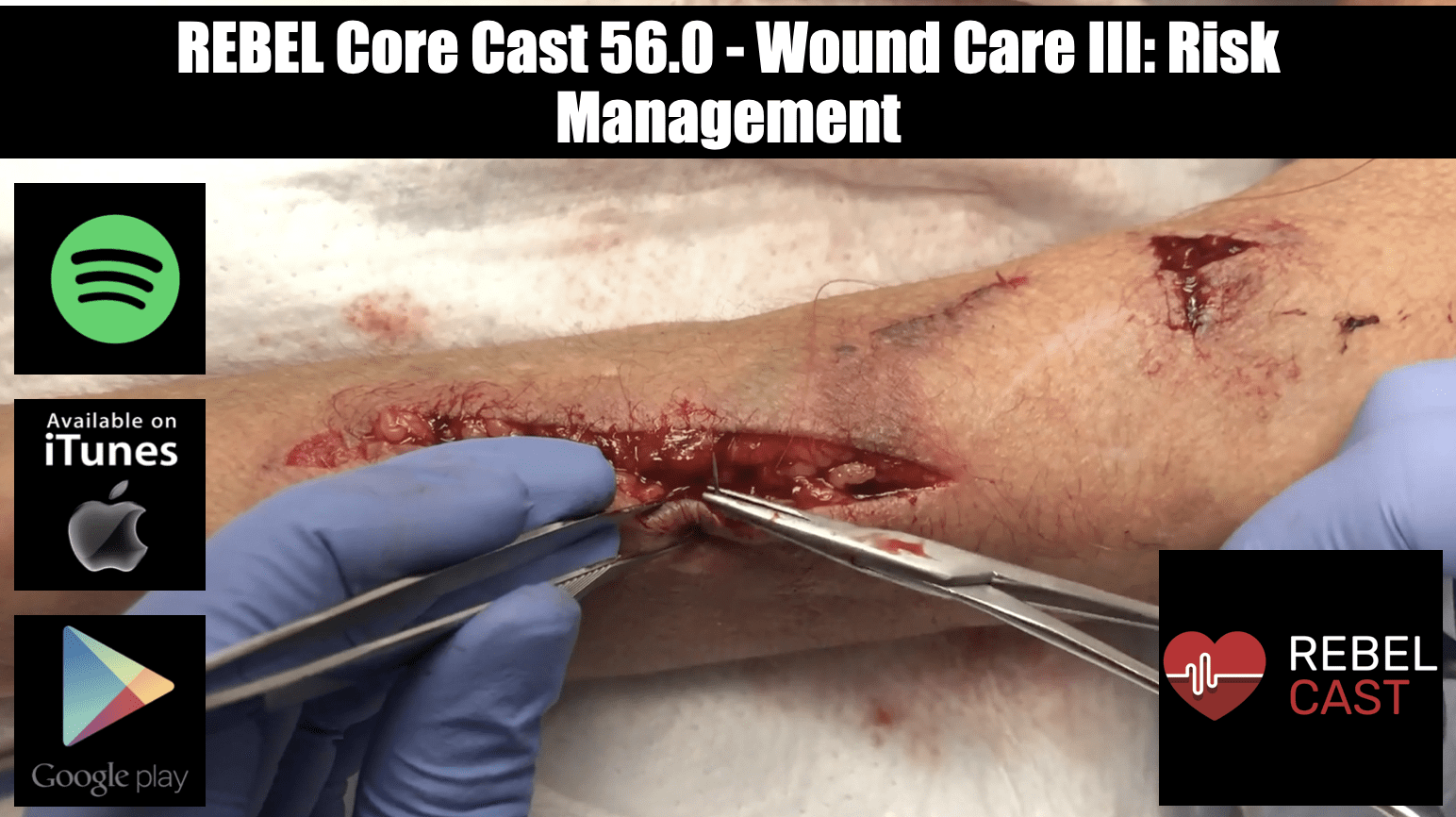
 Take Home Points
Take Home Points
- If youre concerned about a retained foreign body make sure to get imaging
- There is a higher risk of wound infection associated with age, diabetes, wound size, contamination, and a location not on the head or neck. Other conditions that impair wound healing include renal failure, obesity, malnutrition, immunocompromised status.
- Prophylactic antibiotics are not recommended for routine use in wound care.. Antibiotics have a role in select wounds considered high risk for infection.
- Pain control and administration of an anesthetic may be required before a patient can fully cooperate with examination.
- Its ok to get consultation – sometimes the wound is outside of our scope of practice
REBEL Core Cast 56.0 – Wound Care III – Risk Management
Click Here for Direct Download of the Podcast
-
“My patient said he still felt a foreign body near his wound, but I didn’t see anything so I proceeded with the laceration repair.”
- It is important to have a high index of suspicion for a retained foreign body in a wound depending on the mechanism of injury. Appropriate radiological imaging, including x-rays, ultrasound, and CT or MRI if necessary should be used.
-
“The laceration on the hand of my patient with diabetes looked fine after I sutured it, so I just advised them to have the sutures removed in 7-10 days.”
- There is a higher risk of wound infection associated with age, diabetes, wound size, contamination, and a location not on the head or neck. Other conditions that impair wound healing include renal failure, obesity, malnutrition, immunocompromised status.
-
“The patient was in too much pain to move her finger, so I sutured the laceration and told her to follow-up.”
- The provider must assess for injury to tendons and other adjacent structures, fractures, and neurovascular compromise. Pain control and administration of an anesthetic may be required before a patient can fully cooperate with examination.
-
The laceration looked really dirty, so I decided to clean and irrigate it with iodine.”
- Antiseptics have no significant difference in rate of infection compared to wounds that were irrigated with normal saline or tap water. Antiseptics may impede wound healing due to cytotoxic effects.
-
“My patient was anxious to be discharged quickly so I just repaired their complicated lip laceration myself!”
- Proper alignment of the vermillion border in lip laceration repairs is the most crucial step as 1 mm of misalignment can be detrimental to both cosmesis and function. Specialist consultation should be considered in lacerations that violate the vermillion border, the eyelid margin, the lacrimal duct, the tarsal plate or injuries that result in ptosis.
-
“I didn’t want to bother the specialist on call for my patient’s large eyelid laceration and I didn’t think any major structures were involved.”
- Certain laceration locations or injury to underlying vital structures should prompt consultation from the ED. A thorough history and physical will aid in identifying the presence of those qualifying factors.
-
“It was a really busy shift and the laceration looked typical to me. I didn’t ask in detail how the patient came to be injured.”
- Certain mechanisms such as high pressure injuries require surgical consultation and likely operative debridement. The extent of tissue damage may not be readily apparent on initial visual inspection.
-
“The laceration appears to be under some tension, but this adhesive should work just fine.”
- Tissue adhesives should be limited to low tension linear wounds. Wounds under high tension or with jagged edges will likely do poorly with adhesives.
-
“The wound looks okay, but I’ll give the patient some antibiotics just in case.”
- Prophylactic antibiotics are not recommended for routine use in wound care.. Antibiotics have a role in select wounds considered high risk for infection.
Take Home Points
- If youre concerned about a retained foreign body make sure to get imaging
- There is a higher risk of wound infection associated with age, diabetes, wound size, contamination, and a location not on the head or neck. Other conditions that impair wound healing include renal failure, obesity, malnutrition, immunocompromised status.
- Prophylactic antibiotics are not recommended for routine use in wound care.. Antibiotics have a role in select wounds considered high risk for infection.
- Pain control and administration of an anesthetic may be required before a patient can fully cooperate with examination.
- Its ok to get consultation – sometimes the wound is outside of our scope of practice
Read More
Post Peer Reviewed By: Salim R. Rezaie, MD (Twitter: @srrezaie)
The post REBEL Core Cast 56.0 – Wound Care III – Pitfalls appeared first on REBEL EM - Emergency Medicine Blog.
